
© Railway Wonders of the World 2012-


Electrification Overseas
Development of Power Schemes in the Dominions
RAILWAYS OF THE COMMONWEALTH -
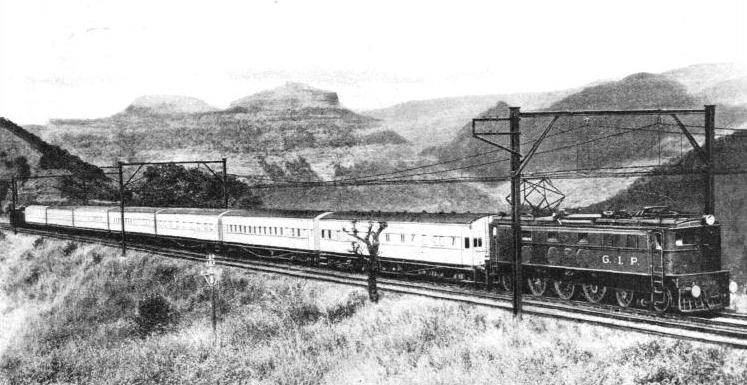
THE “DECCAN QUEEN” on the electrified section of the Great Indian Peninsula Railway provides an excellent example of British railway electrification work overseas. The Great Indian Peninsula Railway has some 182 miles of track electrified on the 1,500 volts DC overhead system.
THE British Empire contains a large number of railway electrification schemes of considerable importance. The electrified railways of South Africa, which include the longest mainline electrification scheme in the British Empire overseas, and one of the longest in the world, are described in the chapter beginning on page 1529. But India, Canada, Australia, and New Zealand have all sections of railway line electrified which deserve the close attention of readers of this work. They deserve attention because they are up-
These schemes in the British Empire have all been carried out by the British electrical manufacturing industry, and are in part responsible for its competitive strength and unrivalled technical experience. It is largely due to the success of railway electrification schemes in the British Empire that so much railway electrification in South America and in Europe has been undertaken by British manufacturers.
We will deal first with India. The first railway electrification scheme in India was inaugurated in February, 1925, and consisted of the Harbour Branch of the Bombay suburban lines of the Great Indian Peninsula Railway. The engineers of the company had reported that the necessary intensification of the steam service along these railway lines could not possibly be considered as economically sound as conversion to electric traction. Suburban traffic was bound to grow along this line, and would eventually necessitate electrification. Before the conversion, the Harbour Branch consisted of a track from Kurla, some nine and a half miles from the main terminus in Bombay, up to a dead end at Reay Road, a few miles outside the city.
It was considered essential to carry this line right into the city, but because of certain restrictions affecting the intervening land, the only way in which the extension could be made was by carrying the track over a large goods yard. This bridging involved two considerable gradients, 1 in 42 on one side of the yard and 1 in 34 on the other side. These gradients practically ruled out economical steam operation, but were feasible with electric working. To have carried the Harbour Branch line into the terminus by any other route would have necessitated disproportionate expenditure. This consideration alone furnishes a good example of one outstanding advantage claimed for electrification, namely, its unique economy for operating on severe gradients.
While work was proceeding on this Harbour line, the decision was taken to extend the suburban electrified section as far as Thana, twenty-
Suburban electrification on this comparatively large scale has certainly benefited the city of Bombay in reducing smoke pollution and making for better traffic conditions. Railway receipts have consistently increased as well.
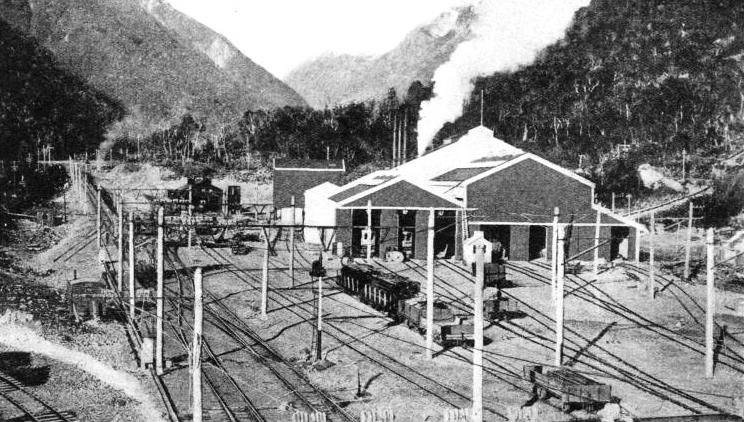
IN NEW ZEALAND. A view of the power-
The track gauge on the G.I.P. is 5 ft 6-
An interesting feature of the motors supplied for the first section of the electrification is that, although they are ventilated machines, they had to be designed so that the ventilating openings could be closed in the event of the track becoming badly flooded. At that time the line in question was subject to periodical flooding at several points during the monsoon season, and therefore the motors were fitted with special air valves so that they might operate satisfactorily even when there was water on the track to a depth of 2 ft. Before the electrification, traffic was often suspended because the water put out the fires of the steam locomotives, but electrical running has at no time been interrupted by flooding.
The electrification of the G.I.P. main lines to Poona (S.E. of Bombay) and to Igatpuri (N.E. of Bombay) was a foregone conclusion once the suburban lines to Kalyan, which is the junction of the Poona and Igatpuri lines, was approved. The Igatpuri ascent includes about twenty-
Main Line Locomotives
The climb over the Bhore Ghat on the Poona line is shorter though more severe, the average gradient for fifteen miles being approximately 1 in 40, with a maximum of 1 in 37. The line then falls for some fourteen miles at an average of 1 in 200 towards Poona.
The locomotives in use on this railway are the main engineering interest of the scheme. The passenger locomotives are each fitted with six 360 hp motors. In service, two are connected in series across a 1,500-
The locomotive body extends the entire length of the frame, with a driving cab at either end connected by a corridor, and with the space between the cabs arranged in three parts. These are a switch and resistance chamber over the four-
The driving motors are mounted in pairs, arranged end to end across the locomotives, and directly above the axle of the driving wheels to which they are geared. This arrangement not only keeps the motors above flood level, but also gives a relatively high centre of gravity, and a good longitudinal and transverse balance -
They are fitted with regenerative braking, and arranged for working in multiple. The forty-
The central body, containing the driver’s cabs and control gear, is built upon one main longitudinal member along the centre, supplemented by the necessary side members. This member connects the two motor units by means of large spherical pivots at either end, which are supported in housings mounted in the bogie frames and through which the tractive effort is transmitted. Four spring-
Developments in India
The inner ends of the bogies are further connected diagonally by a system of rods and bell-
A further section of railway line electrified in India is the Madras suburban line of the South Indian Railway. At present this electrification (1,500 volts DC overhead) extends from Madras south-
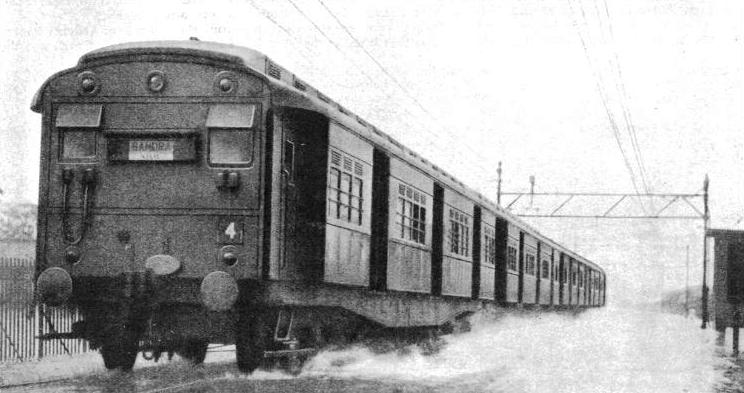
OVER FLOODED LINES caused by the heavy rains of the monsoons at Bombay. The city’s heavy suburban traffic is handled by electric trains working on the 1,500 volt DC overhead transmission system. The electrified lines around Bombay are controlled by the Bombay, Baroda and Central India Railway, and by the Great Indian Peninsula Railway.
Among the most powerful four-
The locomotives are arranged for working in multiple-
To enable shunting operations to be carried out safely and easily, special arrangements had to be made to provide a driving position from which the operator could have a view in both directions. The locomotives are, therefore, constructed with the usual driving position at one end, but at the other end the driver’s cab projects on either side so as to give a clear view up and down the track. This cab is fitted with duplicate controls, one at either side. The arrangement enables the operator to carry out all shunting operations from one end of the locomotive, the driving position at the other end being used only when it is the leading end on long hauls.
This freight yard electrification is interesting in that it shows the advantages of electrical operation in shunting, and, of course, where frequent starting and stopping of heavy trains have to be effected. The system of supply is 2,400 volts, direct current, to conform with an existing electrified section of the Canadian National Railways, through the Montreal Tunnel.
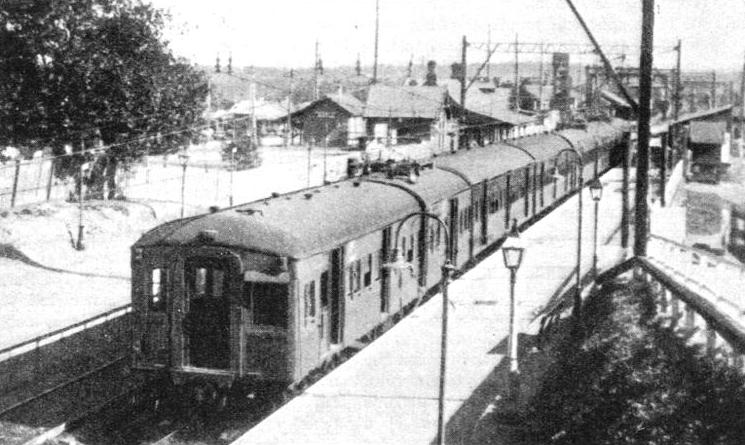
ON THE SYDNEY SUBURBAN LINES. Some 94 route miles round the city are electrically worked by the New South Wales Government Railways on the multiple-
The building of a railway across the Southern Alps which divide the South Island of New Zealand into two halves was one of the great feats of railway engineering in the southern hemisphere. Arthur’s Pass is 3,000 ft above sea-
On the east side of Arthur’s Pass the railway runs to Christchurch and then to the important port of Lyttelton. This latter section is electrified, largely because of the difficulties of working by steam traction a single-
Although the State of Victoria is the smallest on the mainland of Australia, it ranks second in population, with a high concentration around the capital, Melbourne. Because of the high passenger traffic density on the Melbourne railways, electrification was decided upon in 1913, but it was interrupted by the war of 1914-
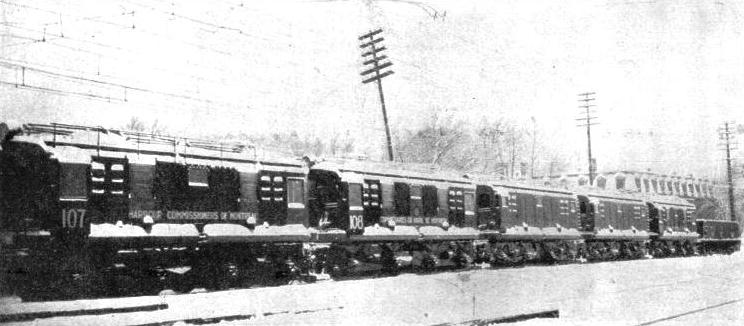
AT MONTREAL, CANADA. The Harbour Commissioners of Montreal operate nineteen miles of electrified track around the great port. Trains are worked by overhead transmission at 2,400 volts DC. Above are five 100-
Partial electric services began on the Melbourne suburban lines in May, 1919. One advantage gained by electric working was an increase in the number of passengers carried from ninety-
The electric services are operated by multiple-
Progress in Australia
A 78,000-
Beyond this area overhead transmission is employed, the 20,000-
A feature of both the Melbourne and Sydney electrified suburban sections is the electric express parcels service trains, which are widely used. In Melbourne, electric parcel trains running to fast schedules handle nearly all the parcel traffic between Melbourne and suburban stations.
Sydney is the centre of a wide and boldly planned electrification scheme by which the bulk of all railway traffic to the north, south, east, and west is handled electrically to a distance of about twenty miles from the centre of the city. The continuous improvement which is being effected in the urban transport of Sydney is shown by the new Sydney Harbour Bridge with its four electrified tracks. There are now over 94 route miles electrified round Sydney on the 4 ft 8½-
The first motor-
The Sydney railway system provides a splendid example of intelligent planning and adaptation to the needs of one of the Empire’s largest cities.
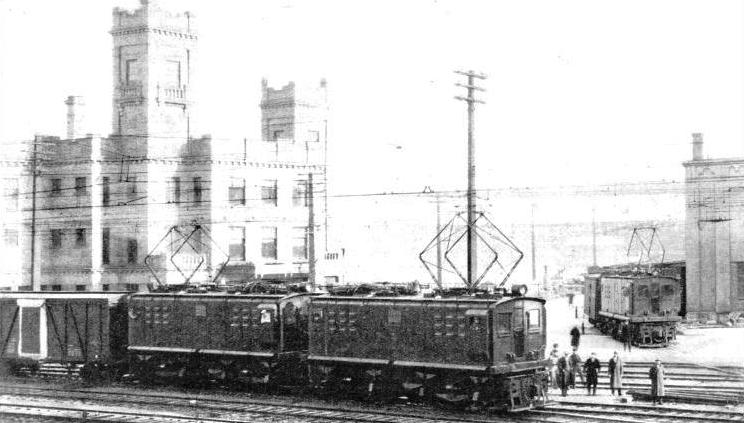
HEAVY FREIGHT TRAINS at Montreal Harbour hauled by 100-
You can read more on “Electrification in Europe”, “Electric Locomotive Classification” and “Electric Power on the Grand Scale” on this website.